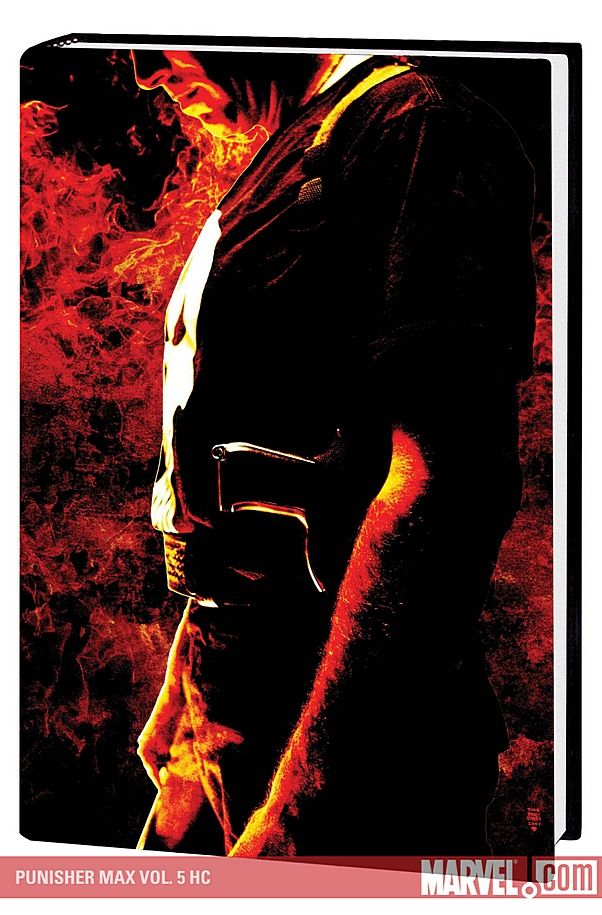The fifth oversized hardcover volume of "Punisher MAX" collects "Long Cold Dark" and "Valley Forge, Valley Forge," concluding Garth Ennis' phenomenal five-year run on the book that has defined the character of Frank Castle unlike any other writer's work on the character. By the final page of this volume, it's easy to see why some say they have no need for further Punisher stories, that everything to say and do with the character has been said and done, that Garth Ennis has, by taking the character to new heights of quality, ruined the character forever. It's that damn good.
What Ennis does in this volume is conclude one of the most elegant and nuanced five-year stories I've ever read. Ostensibly containing ten story arcs (plus two more mini-series and three one-shots), the 60 issues of "Punisher MAX" Ennis wrote comprise one larger story where these final two are heavily indebted to what came before without actually requiring that you read them to understand what's going on. In fact, you may not even notice that it's one big story, because it's that well executed and organic. The return of Barracuda, the black monster that is bigger, stronger, and deadlier than the feared Russian of "Welcome Back, Frank," wherein he kidnaps and threatens the child Castle never knew about, is almost divorced from the previous stories it stems from. The facts of who the Barracuda is, how Castle fathered a child, and how Barracuda found out about it when Castle had no idea it existed are explained with ease and fit into the story perfectly, never interrupting it to stop and catch anyone up.
However, discussing the structure or the plot of this volume seems misplaced. By this point in the series, Ennis had moved past those concerns, preferring to focus on ideas. "Long Cold Dark" examines fatherhood as, suddenly, the Punisher is no longer the Punisher, he's a father again, and had to cope with those concerns. He's been fighting a war where his only reason to survive is to kill more bad guys the next day. He knows he will die someday and accepts that, but with a daughter in danger, she is his only concern. It's a burden he's unfamiliar with and while 'Garth Ennis writing the Punisher with a baby daughter' may seem like a funny romp to some, it's as serious and crushing as anything I've read.
"Valley Forge, Valley Forge" takes things further as Ennis ties the previous four-and-half years together with the culmination of story where eight generals in the US army send a Delta Squad to capture Castle and retrieve a tape proving their involvement in some very questionable behavior involving terrorists, Russians, and a deadly biological weapon. More than that, it's an arc where Ennis reexplores "Born," the mini-series he did with Darick Robertson about Castle's third tour in Vietnam and, possibly, the true birth of the Punisher. He uses a book about the attack at Valley Forge where Castle was the sole survivor as juxtaposition against the story. Each issue features excerpts, mostly prose, but also pictures. In a story about the military, the United States' use of it, honor, debt, and what is right, Ennis manages to both evoke tremendous emotional attachment and deliver scathing, brutal, honest commentary that seems more in line with his war comics, but fits in perfectly here.
Ten of the eleven issues collected are illustrated by Goran Parlov with colors by Lee Loughridge, an art team that complements Ennis's writing just as well as any other that's normally associated with the Irish writer. The other issue is done by Howard Chaykin and it's not often that Chaykin is outdone by an artist, but, here, Parlov stands above him without question. The stark, purposeful lines of Parlov's art are as direct as Ennis' words. It's a very basic, no-nonsense style that suits the Punisher. Not a single unnecessary line or cluttered page. Frank Castle looks like a man his age; a man whose face has been carved and chiseled over the years from his brutal lifestyle. He's an imposing figure, one that makes even special ops think twice about messing with.
Parlov has an incredible ability to bring out emotion from hard men that show little. In the final pages of "Valley Forge, Valley Forge," Nick Fury finishes reading the eponymous book on the Punisher in a bar and sees news footage of the current conflict in Iraq, and the visual transformation that he undergoes in those four pages is some of the best, most powerful art I've ever had the good fortune of seeing. It's subtle, it's nuanced, but it's also obvious. The careful movements, the way he sets down a book and takes a drink, and the look on his face as he says "Same again" tell you everything you need to know about the man at that moment. As does the final page as the Punisher walks away, as he always does and always will, having killed men that deserved killing, not looking satisfied or content, but off to kill more because that's all he knows how to do anymore.
And while the Punisher may always continue on killing people, it will be hard work for anyone who wishes to top what Garth Ennis did with the character as this volume concludes that seminal, amazing, marvelous, fantastic run with two powerful, deep, and impacting stories full of violence, pain, misery, and intense emotion. You should own these comics as they are the finest Punisher stories you're likely to find anywhere and, possibly, the finest work in Garth Ennis' stunning career.

